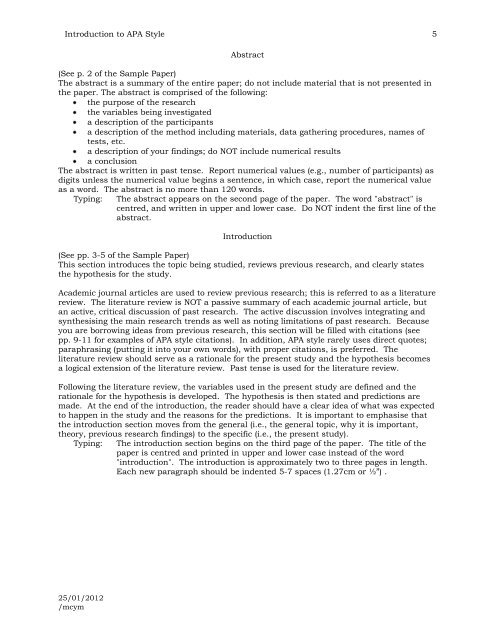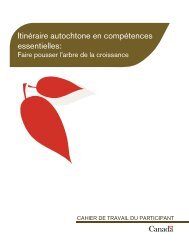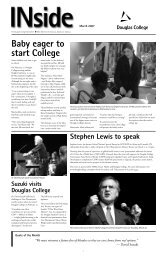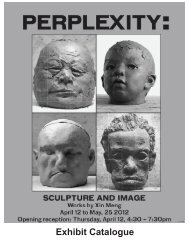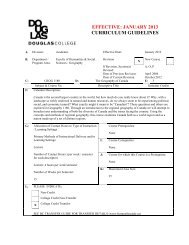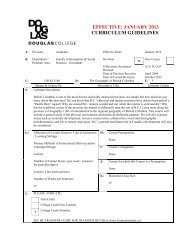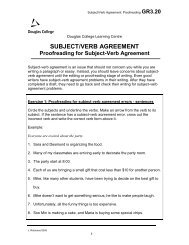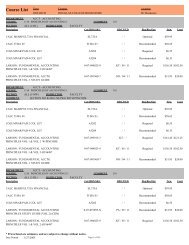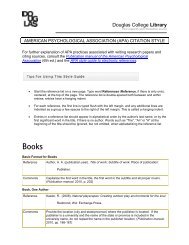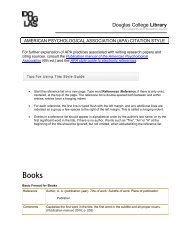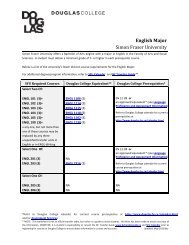An Introduction to APA Style - Douglas College
An Introduction to APA Style - Douglas College
An Introduction to APA Style - Douglas College
You also want an ePaper? Increase the reach of your titles
YUMPU automatically turns print PDFs into web optimized ePapers that Google loves.
<strong>Introduction</strong> <strong>to</strong> <strong>APA</strong> <strong>Style</strong> 5<br />
25/01/2012<br />
/mcym<br />
Abstract<br />
(See p. 2 of the Sample Paper)<br />
The abstract is a summary of the entire paper; do not include material that is not presented in<br />
the paper. The abstract is comprised of the following:<br />
the purpose of the research<br />
the variables being investigated<br />
a description of the participants<br />
a description of the method including materials, data gathering procedures, names of<br />
tests, etc.<br />
a description of your findings; do NOT include numerical results<br />
a conclusion<br />
The abstract is written in past tense. Report numerical values (e.g., number of participants) as<br />
digits unless the numerical value begins a sentence, in which case, report the numerical value<br />
as a word. The abstract is no more than 120 words.<br />
Typing: The abstract appears on the second page of the paper. The word "abstract" is<br />
centred, and written in upper and lower case. Do NOT indent the first line of the<br />
abstract.<br />
<strong>Introduction</strong><br />
(See pp. 3-5 of the Sample Paper)<br />
This section introduces the <strong>to</strong>pic being studied, reviews previous research, and clearly states<br />
the hypothesis for the study.<br />
Academic journal articles are used <strong>to</strong> review previous research; this is referred <strong>to</strong> as a literature<br />
review. The literature review is NOT a passive summary of each academic journal article, but<br />
an active, critical discussion of past research. The active discussion involves integrating and<br />
synthesising the main research trends as well as noting limitations of past research. Because<br />
you are borrowing ideas from previous research, this section will be filled with citations (see<br />
pp. 9-11 for examples of <strong>APA</strong> style citations). In addition, <strong>APA</strong> style rarely uses direct quotes;<br />
paraphrasing (putting it in<strong>to</strong> your own words), with proper citations, is preferred. The<br />
literature review should serve as a rationale for the present study and the hypothesis becomes<br />
a logical extension of the literature review. Past tense is used for the literature review.<br />
Following the literature review, the variables used in the present study are defined and the<br />
rationale for the hypothesis is developed. The hypothesis is then stated and predictions are<br />
made. At the end of the introduction, the reader should have a clear idea of what was expected<br />
<strong>to</strong> happen in the study and the reasons for the predictions. It is important <strong>to</strong> emphasise that<br />
the introduction section moves from the general (i.e., the general <strong>to</strong>pic, why it is important,<br />
theory, previous research findings) <strong>to</strong> the specific (i.e., the present study).<br />
Typing: The introduction section begins on the third page of the paper. The title of the<br />
paper is centred and printed in upper and lower case instead of the word<br />
"introduction". The introduction is approximately two <strong>to</strong> three pages in length.<br />
Each new paragraph should be indented 5-7 spaces (1.27cm or ½”) .


